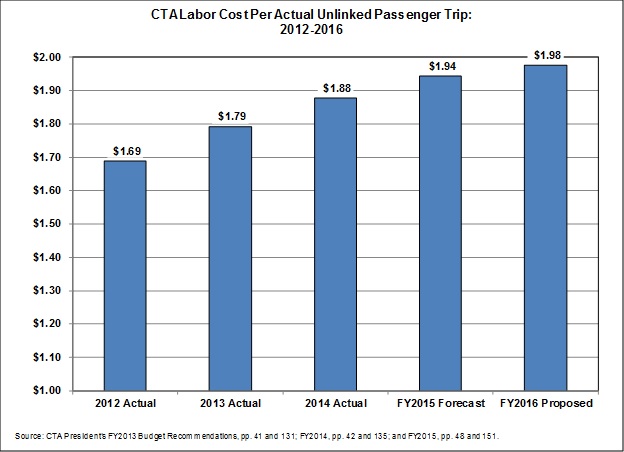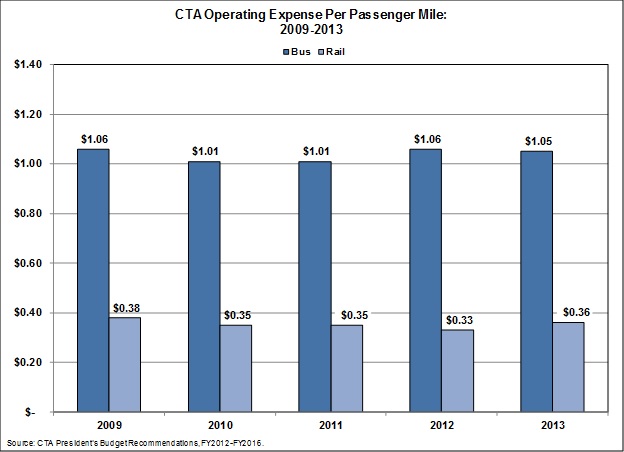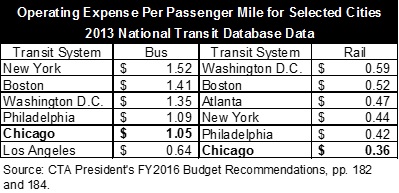November 19, 2015
The Chicago Transit Authority (CTA) recently released its FY2016 proposed budget. While the Civic Federation traditionally analyzes features common to all local government budgets, our analyses of the Chicago Transit Authority’s (CTA) budgets include a review of the Authority’s productivity measurement data. The Civic Federation uses expenditures, ridership and miles traveled data provided by the CTA to gain insight into changes in productivity.
The Civic Federation uses two measures to assess the CTA’s productivity over time: labor cost per actual unlinked passenger trip and operating expense per passenger mile.[1] The labor cost per actual unlinked passenger trip measures labor productivity and operating expense per passenger mile is a common productivity measure used by transit agencies. The data used to calculate both of the productivity measures is obtained from the annual budget documents. In order for the CTA to be eligible for grant funding from the Federal Transit Administration, the Authority must self-report certain data to the National Transit Database program, including operating expense per passenger mile.[2]
Labor cost per actual unlinked passenger trip is calculated by taking the total labor cost divided by the total system wide ridership. A lower dollar amount indicates higher productivity. The labor cost per unlinked passenger trip indicator increased steadily from $1.69 in FY2012 to $1.98 in FY2016.
Between FY2012 and FY2016, productivity has declined because ridership, which fell by 0.7% on average each year, has not kept pace with labor costs, which grew by 11% on average each year. As a result, the ratio has steadily increased over the five-year period. According to the CTA, the decrease in ridership was the result of track construction, increased rates in fare passes in FY2013 and extreme winter weather in FY2014 and FY2015. The labor cost per unlinked passenger trip is expected to increase between FY2015 and FY2016 by $0.04 from $1.94 to $1.98. This will be due to a 2.5% increase in labor costs compared to a projected 0.7% decrease in ridership from the previous year.
Another indicator that provides information about the productivity of the CTA’s operations is operating expense per passenger mile for bus and rail service.[3] The latest data available for this indicator is provided for 2013 by the Federal Transit Administration’s National Transit Database Program.
The chart below illustrates operating expense per passenger mile for bus and rail service between 2009 and 2013, the most recent years for which data is available. As with all transit systems, rail service is more cost effective than bus service because there is higher ridership on rail service. The operating expense per passenger mile for rail service has fluctuated over the past five years from a high of $0.38 in 2009 to its lowest point in 2012 of $0.33 before increasing slightly again in 2013 to $0.36 per passenger mile. The average of the five-year period is $0.35 per passenger mile.
The operating expense per passenger mile for bus service has also fluctuated over the last five years, from a low of $1.01 in 2010 and 2011 to a high of $1.06 in 2009 and 2012 before declining again slightly in 2013 to $1.05 per passenger mile. The average of the five-year period is $1.04.
The following chart compares CTA’s operating expense per passenger mile for bus and rail service with selected cities. These transit systems were selected by the CTA to be comparable for its budget reports based upon the size of the urban area served, the urban characteristics of the service area, and the size of the transit system.[4] For bus transit, the CTA’s 2013 operating expense per passenger mile for bus service was the second lowest for cities examined. For rail transit, the CTA’s 2013 operating expense per passenger mile is the lowest when compared with the mass transit systems in other major cities.
Overall, the productivity measures for the CTA show mixed results. The CTA’s productivity has declined in terms of labor cost per actual unlinked trip. On the other hand, the operating expense per passenger mile for bus and rail service has fluctuated over the last five years, but stayed relatively flat. However, the CTA continues to perform better than its peer agencies with regard to bus and rail operating efficiency.
[1] “Ridership” and “unlinked passenger trips” refers to total number of rides. Each passenger is counted each time that passenger boards a vehicle (bus or rail). CTA President’s FY2016 Budget Recommendations, p. 206.
[2] National Transit Database, http://www.ntdprogram.gov/ntdprogram/ntd.htm (last accessed November 10, 2015).
[3] Operating expenses are costs associated with the day-to-day operations of the delivery of service for a transit agency and typically includes labor, material, fuel, power, security and professional services. CTA President’s FY2016 Budget Recommendations, p. 203.
[4] CTA President’s FY2016 Budget Recommendations, p. 179.






